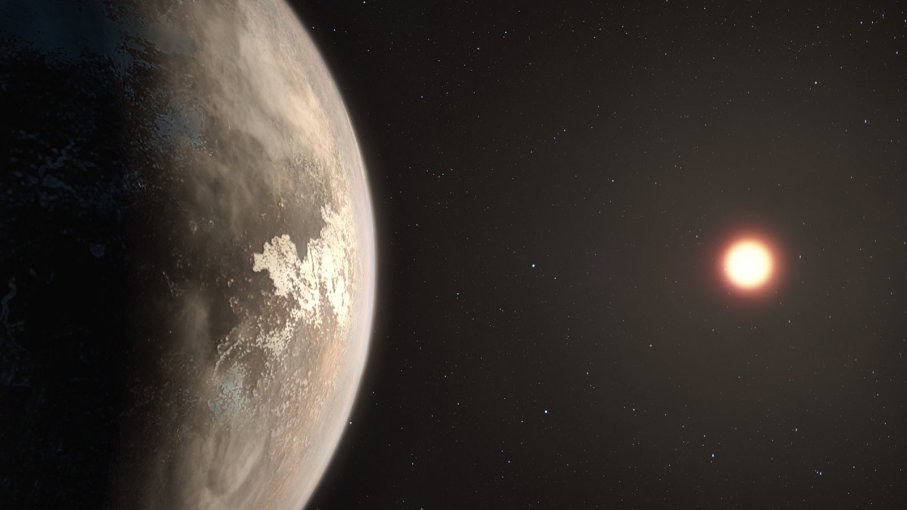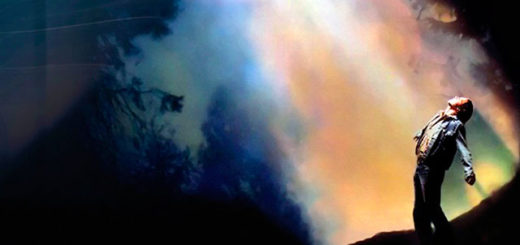Nearby Earth-sized Alien World Orbits ‘Quiet’ Star, Boosting Habitable Potential

An artist’s impression of Ross 128 b, with its red dwarf parent star in the background. That relatively calm red dwarf star is a big boost for the exoplanet’s habitability. ESO/M. KORNMESSER
A very special alien world has been discovered on our galactic doorstep, and it may have the secret sauce that allows life as we know it to exist on its surface.
Enter Ross 128 b, an Earth-sized exoplanet that likely orbits its star in its habitable zone. What makes this exoplanet discovery so exciting is that it’s located only 11 light-years away. Plus, its red dwarf star appears to be inactive. That means that this newly discovered world may not face the radioactive ravages that other “habitable” exoplanets must endure, thereby boosting its habitable potential.
Astronomers detected Ross 128 b using the European Southern Observatory’s High Accuracy Radial-velocity Planet Searcher (HARPS) at the La Silla Observatory in Chile and measured the slight “wobbles” of the star caused by the orbiting exoplanet. From the study, published in the journal Astronomy & Astrophysics, the researchers calculated the exoplanet’s mass and orbital period. A year on Ross 128 b is slightly less than 10 days, so the distance at which it whips around the star is very close. But as the red dwarf is so tiny and cool, the exoplanet receives a similar amount of solar heating as our planet receives from the sun.
Ross 128 b vs. Proxima b
Red dwarfs are the most common type of star in our galaxy, and many are known to possess planetary systems. The closest star to our solar system, for example, is Proxima Centauri and, in 2016, astronomers made the historic discovery of a small Earth-sized exoplanet in orbit. That world — called Proxima b — is the closest habitable zone exoplanet to us and may have a temperate atmosphere that could support its own alien biosphere.
However, Proxima Centauri is an angry little star that regularly erupts with powerful flares and pumps out deadly X-ray and ultraviolet radiation. If life could evolve on Proxima b (and that’s a big “if”), the planet would need a very powerful magnetosphere (a global magnetic field) to deflect powerful stellar winds to prevent its atmosphere from being stripped away and any extraterrestrial biology from being irradiated.
Ross 128 b, on the other hand, lives next to an inactive red dwarf star – one that isn’t blasting local space with a massive dose of radiation. In fact, according to an ESO statement, Ross 128 is the quietest nearby star to host such a temperate exoplanet. Despite being 20 times closer to its star than Earth is to the sun, Ross 128 b only receives 38 percent more radiation. If it does have an atmosphere, life might have had an opportunity to gain a foothold without getting fried.
Locked Up and Uninhabitable?
Although radiation may not be a problem, orbiting so close to a red dwarf star presents a unique situation for habitable zone exoplanets like Ross 128 b.
“Tidal lock[ing] is expected for Ross 128 b,” says Nicola Astudillo-Defru, who works at the Geneva Observatory, University of Geneva in Switzerland, and is co-author of the study.
Tidal locking occurs when a planet orbits close to its star. Like the moon is tidally locked with Earth (the reason why we only ever see one hemisphere of the moon facing us as it orbits the planet), exoplanets with compact orbits are also expected to become tidally locked with their stars — one hemisphere is perpetually facing the star, and the other hemisphere is always facing away.
“Depending on the nature of its atmosphere or the presence of oceans, the heat can be efficiently distributed from the warm side facing the star to the cool side in perpetual night,” Astudillo-Defru tells HowStuffWorks. “Accordingly, a tidally locked planet may still be potentially habitable.”
For now, however, though Ross 128 b is an exciting discovery, there’s no way of knowing if the nearby world even possesses an atmosphere, let alone whether that hypothetical atmosphere has the right chemical balance for life to thrive.
Extremely Large Telescopes
When the next generation of ground- and space-based telescopes go online, such as the ESO’s Extremely Large Telescope (ELT) and NASA’s James Webb Space Telescope (JWST), Ross 128 b will become a prime target for astronomers to look for the spectroscopic clues of chemicals that could be produced by an alien biosphere.
“When the ELT comes online – at the middle of the next decade – it will provide both the collecting power and the angular resolution to observe Ross 128 b,” says lead author Xavier Bonfils, who works at the Université Grenoble-Alpes/CNRS in Grenoble, France.
Bonfils and Astudillo-Defru say telescopes like the ELT will be on the lookout for water, a substance that is essential in its liquid form for all life, but also possible biomarkers.
“It would [be] extremely exciting to discover dioxygen, ozone, methane, and/or carbon dioxide,” says Astudillo-Defru, as these biomarkers could betray the presence of a habitable, or possibly even inhabited, atmosphere.
“Each [biomarker] would be super exciting and an important step toward the evidence of life outside our solar system,” adds Bonfils, though, individually, none of these chemicals would provide definitive proof for life.



 Creators of mankind
Creators of mankind Description of “Tall white aliens”
Description of “Tall white aliens” Where they came from?
Where they came from? About hostile civilizations
About hostile civilizations The war for the Earth
The war for the Earth “Tall white aliens” about eternal life
“Tall white aliens” about eternal life Video: “Nordic aliens”
Video: “Nordic aliens” Aliens
Aliens Alien encounters
Alien encounters The aliens base
The aliens base UFO
UFO Technology UFO
Technology UFO Underground civilization
Underground civilization Ancient alien artifacts
Ancient alien artifacts Military and UFO
Military and UFO Mysteries and hypotheses
Mysteries and hypotheses Scientific facts
Scientific facts


















